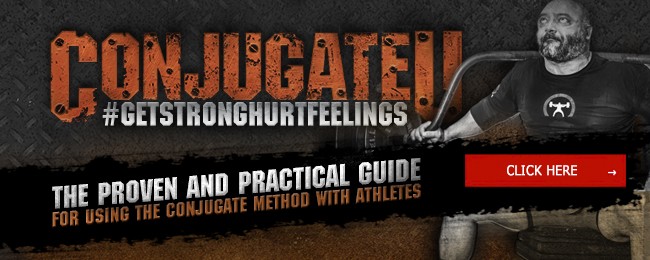
As time goes by, I am getting more questions about how to implement the Dynamic Effort Method (DEM) with beginners. This is good because more people are starting to think about using this method early on in their athletic training. Many people will say, “Don’t do it with beginners” and it’s a good thing I’m somewhat anti-establishment because DEM has been a great tool in the development of a lot of beginner-athletes. The simple answer is: just do it. Put it in the training, get it rolling, and don’t overthink it.
RECENT: My RPR Level I Certification Workshop Experience
Before we just do it, though, let’s talk about some of the questions or hesitations I think people have.
How do I utilize speed work if I don’t have a max for the athlete?
Use the speed work for teaching and on training day. You don’t need to know their max. For one, it’s probably not accurate because their box squat at this point probably looks horrible. So, it’s going to either be overestimated because they cheat like hell to get a higher number than they should have or it will be way undershot because they actually have to hit depth and use some hip musculature. My point is, who cares what their max is in the beginning?
Use this article and video to teach them on Day 1: How to Teach and Coach the Box Squat.
While they are doing their sets of two, go around the room and set their speed weights for them. You may spend 20–30 minutes speed squatting, but you are making a ton of progress in the long run. Pick a weight for the athlete so that they have to put some good effort into it but they still come off the box with some pop. Here is a good example (pay attention to the acceleration off the box and bar speed):
If the load is too light, the athlete won’t be able to put enough effort into the bar and it will look like a total joke for them. If you get too much weight on the bar, form will fall apart and the speed won’t be there. In that case, just take a little weight off. There you have it—their speed weight is set. You are off! They are training, practicing the important skills of effort and acceleration, and you are getting a training effect on Day 1.
Some people say that beginners shouldn’t do speed work. Is it appropriate for beginners?
There are some good arguments against speed work for beginners, and below are some reasons I have had success with it:
- It lets the athlete practice and think their way through a very important weight room skill that will eventually increase dynamic correspondence from the room to the field. I can’t tell you how many times I’ve heard strength coaches bash their athletes about how bad they are at squatting. This method gives them both a chance to succeed and a training response at the same time. We see this all the time: coaches want to do anything but the given exercise to get better at the given exercise. They say, “My athletes aren’t ready to squat,” so we start using all sorts of crazy methods to get ready to do one of the most basic weight room skills. Here’s an idea—drop the weight down, make the learning curve smaller, and I bet they’re readier than you think.
- Many beginners and their sport coaches are scared of heavy weight in the beginning. The DEM paired with the right accessory work will allow you to build strength while you earn the athletes’ and coaches’ trust and transition to heavy training.
- It teaches them to move fast. Again, coaches will complain that their athletes aren’t strong enough to be explosive. This might be true, but many times they just don’t understand it. You may have to teach them. This method can also be used to help teach some aggression towards the bar. They have to push hard and fast, and this is how you teach that. I recently employed speed work exclusively for lower body training with a beginner online client who could not dunk when we started. After eight weeks of just speed work, accessories, and playing his sport, he’s throwing himself alley-oops off the backboard and reverse dunking.
- The majority of the athletes will typically be moving the bar fast enough within the first couple of sessions to get the desired training effect of the speed work. It is up to the coach to manipulate the loads if you don’t have the percentages yet. This is where the physics come in. If f = ma, then we can increase the a (acceleration) greatly and continue to produce a large amount of f (force).
The DEM can be a great tool for beginners. Go from 0 to 60 as fast as possible or statically overcome by DEM (the same type of contraction used to perform box squats and speed pulls). The dynamic day helps build this ability. So much of sporting performance is first-step speed (static overcome by dynamic). Yes, maximal strength must be built to overcome inertia, but you also have to practice this type of contraction. How many times have you heard a coach say, “We need to work on first-step speed”? Most athletes are not good at this skill because they have drawn on the stretch reflex their entire life. Properly executed box squats and speed pulls will raise this skill.
Implementing a dynamic day can also aid in recovery. It is VITAL to build recovery into your training because—here is a news flash—90% of your athletes WILL NOT make the effort to do extra recovery techniques on their own. The lighter loads and relatively wider stance used in this method allows us to train a weakness without crushing the athlete with constantly heavy weights. To further aid in the recovery aspect, try to pick accessory lane movements that are less taxing to the body. For example, a reverse hyper as opposed to doing Romanian deadlifts. Use a lot of single-joint movements for accessory work on this day. This is where you use movements other than the main movement to bring up the squat and eventually other sporting abilities. This allows us to bring up weak areas without crushing the athletes in the weight room. REMEMBER, your training has to aid in the athlete’s performance. If they are constantly smashed from your training program and can’t perform in practice, this process can’t happen. Pick your movements wisely.
This method builds tremendous strength, explosiveness, and work capacity! The lighter loads allow the athlete to handle large volumes. One of the keys to the DEM’s effectiveness is the short rest periods between sets. Unlike most “explosive” training where you get to fully recover between sets, keep your rest periods short between sets on dynamic days. Typically, rest 30-45 seconds if possible. If you have your athletes training in groups of two to four just have them get through their sets with as little rest as possible. As soon as their partner is off, the next person should be lifting. Encourage them to try to kick each other’s ass. I want my training partners leaning on stuff by the end of the workout while I’m standing tall! If you are not fully recovered from your previous set, your body will tap into muscle fibers it normally would not if you were fully recovered. Sounds similar to the theory behind French Contrast Training, which is all the rage lately, doesn’t it?
In short, don’t overthink this method. The main objective is to move a submaximal weight fast or with maximal effort. You can make a large amount of progress for a long time without knowing your athlete’s back squat max. In the end, our main objective is sport performance anyway, right? So, do we really need a squat max at all?











Day 1 - max lower
Day 2 - max upper
Day 3- combo speed.
Later on we found this seemed to work better:
Day 1- max upper
Day 2- speed lower
Day 3- speed upper
Day 1- max lower
Day 2- max upper....
so you train 3xs per week but keep all 4 days in. The program is just spread out a little.